► Cupra’s take on the future of motor racing
► It involves wearing a VR headset at the wheel of a car…
► … and razzing around an empty car park
Cupra is a young brand, which means it has the freedom to explore new ideas. That’s a real luxury in the car industry. Enduring, prestigious brands such as Porsche and Ferrari often lock horns with their fanbase each time they introduce a technological innovation.
For example, when Porsche switched the 911’s power steering from hydraulic to electrical assistance in 2011, hordes of prescriptive devotees hurled vitriol at the company, simply because the change distanced the new car from the classic 911. It wasn’t how it used to be. Which is wrong. Apparently.
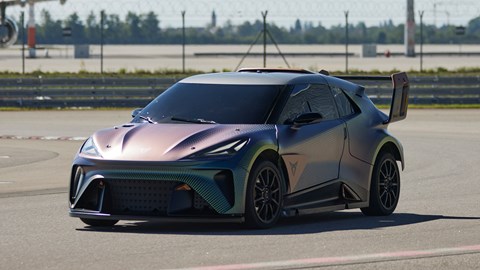
But Cupra can basically do whatever it wants because every one of its customers is a new customer. It doesn’t have a heritage to uphold or a loyal fanbase to appease – and these liberties encourage bravery. Just look at its new DarkRebel concept. Cupra felt it didn’t rock the boat hard enough with its bold, shooting brake EV, though, so to test the limits of its bravery, the brand has created a new semi-virtual race car which allows the driver to tear around at race pace whilst wearing a VR headset. Crazy, we know.
When Cupra told us we’d be driving this new concept racer, we envisaged an expensive accident in our immediate future. Crashes are normally inevitable when you drive a car under the influence of blindness – and, if it isn’t clear enough from the images, once you have the headset on, your visual connection to the physical world is cut. All you see is an arcade-style video game racetrack. You just have to trust there aren’t any obstacles in your real-world path.
So, how does this VR-equipped racer work?
In the back of the car, there’s a powerful computer that runs the VR headset and the game it displays. The VR goggles are hard wired into the cabin and there’s a camera mounted on the dashboard that tracks the driver’s head movements so, when you move your head in real life, the virtual world you see through the headset moves with you.
The computer also receives a constant stream of data about the position of the car’s pedals and steering wheel, which allows the virtual world to react in lockstep with the adjustments you make in the meat realm. And, just in case it all goes pear-shaped, there’s a Cupra racing driver sat in the passenger seat with one hand on the handbrake and the other on a massive kill switch.
The upshot of all this clever tech (and a particularly patient racing driver) is that you can experience a virtual reality racetrack without any motion sickness. A common problem with conventional VR racing games is that the motion you view through your goggles isn’t synced with the G-forces you sense through your body – and that cognitive dissonance makes you feel sick because your brain can’t figure out whether you’re moving or not.
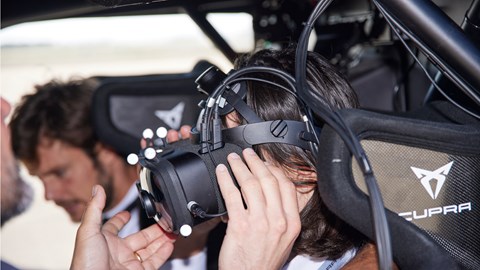
You don’t get that with the Exponential Experience Concept, though. Turn a right-hand corner in the game and you’re slammed into the left-hand side of your seat, just like you would be in a real race car – because you’re really driving a real race car. You just have a screen on your face.
The technology also means that racing rivals don’t need to be in the same place to have a tussle. Providing they both have an Urban Rebel racer and an empty car park to skid around in, they could connect to one another through the internet and race wheel-to-wheel in the virtual world. Cupra’s even trying to engineer a system that’ll make the physical car react if you bump into an opponent in the game.
What’s the point of the technology? It sounds a bit fanciful
We grappled with this once we’d stepped out the car. We could appreciate the hard work that went into developing the concept, but we didn’t really understand the point of it. We’d rather have driven the car without the VR headset. But Cupra reckons the technology could make motorsports more attractive to younger audiences by presenting it in a format that appeals to them.
Cupra says Gen Z is more interested in both playing and watching video games than they are in motorsports. So, the company is currently forging a partnership with a major video game streaming platform (Cupra hasn’t confirmed which one yet – but think the likes of Twitch or YouTube Gaming) so it can livestream the digital and physical elements of its semi-virtual racing series.
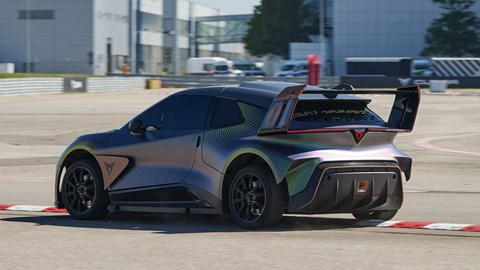
It’s big business, too. Twitch says its platform hosts an average of 35 million visitors every day. To put that figure into context, the cumulative TV audience for the entire 2022 Formula One racing season (which lasts eight months) was around 1.54 billion. That means Twitch attracts the equivalent of F1’s entire yearly viewership every 44 days. Obviously, Cupra wants in on that hustle.
What does it feel like to drive?
Once you’re over the fear of bumping into stuff you can’t see, it’s surprisingly natural. The biggest drawback we recognised was the lack of peripheral vision, but the sensation isn’t too far removed from driving around a track whilst wearing a crash helmet. And Cupra assures us that the peripheral vision issue will improve with the next generation of VR headsets.
Cupra hasn’t tried to ape the meat realm with the concept, either. The view from inside the VR goggles is like a neon version of the classic arcade racer Out Run, although some elements from modern racing sims have been thrown in for good measure. For example, there’s a racing line on the virtual tarmac (like you get in Forza Motorsport) that pops up with red warning triangles when you’re approaching the braking zone for a corner. If you’re a keen racing gamer, it’ll all feel very familiar.
By the time our second lap rolled around, we felt more comfortable with the controls and were able to push a little harder. Our lap times started to tumble because – and here’s the strangest part – this VR-equipped concept is far less scary to drive quickly than a normal car. It must be something to do with fact there’s a barrier between your face and the real-world accident you’re trying to avoid.
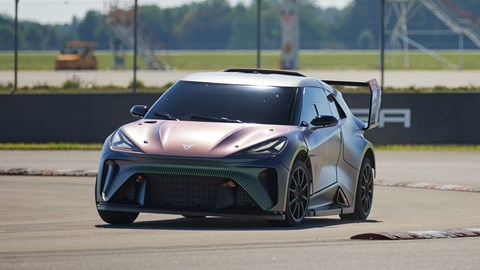
And you really can press on. The Urban Rebel is a seriously well-balanced car. The steering is joyfully communicative and there’s virtually no understeer. There’s also quite a lot of power. The racer has two electric motors producing 429bhp and, because it only weighs a shade over 1.2 tonnes, it accelerates like it’s been dropped from a crane.
Because it has such an enormous amount of power, you can also make it oversteer if you’re exuberant enough. We didn’t get it particularly sideways, but we watched one of Cupra’s racing drivers smoking around the track like a semi-digital Ken Block.
The biggest thing for us, though, was the noise. Unlike almost every other electric car we’ve driven, the Urban Rebel racer makes a proper racket. Its motors whine like a straight-cut gearbox from a classic rally car and there’s a constant background hum, which sounds a bit like a transformer being fed into blender. It was great to experience such savagery from a stereotypically clinical powertrain. Cupra just needs to capture that sensation for its next generation of electric road cars.
Is this the future of motor racing, then?
Probably not. We spoke to several Cupra representatives and it quickly became obvious that this is more of a technical exercise than it is a disrupter for the likes of Formula One. Naturally, Cupra wants its new technology to be in the public eye, but it doesn’t want to sideline traditional motorsports to achieve that.
Gavin Cheng, CEO of the eSports network FTW Worldwide (and a consultant for Cupra’s Exponential Experience project) said: ‘It’s an exploration. Nothing will ever replace, in Cupra’s mind, the thrill of actually driving a vehicle. This is core to them. On the other side, you have a generation raised on games. Gaming, influencing, Gran Turismo, Valorant – whatever it is – there’s this whole digital world that’s out there.
‘So, the idea is – is there a future evolution of motorsport that combines these two things while keeping the root of physical driving?’ He expanded on this sentiment, saying: ‘It’s about pushing the intersection between the digital and the physical world. And how can the core spirit of racing be honoured and brought in the new generation?’
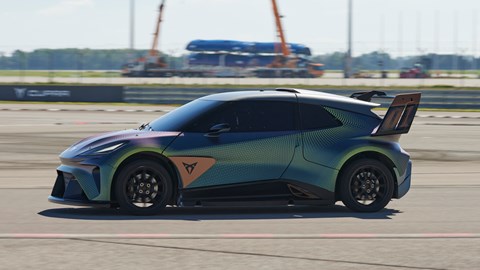
We hope his vision bears fruit and that, instead of displacing motorsports altogether, Cupra’s Exponential Experience will grow into a sort of ‘gateway drug’ to get younger, streaming-savvy Gen Z audiences engaged with physical motorsport. It seems they’re tricky to court, though.
Our most important take away from the day was that, if traditional motorsports want to keep a steady audience well into the future, they need to work harder on their social media campaigns and audience engagement. The upcoming Gen Z viewership won’t give a monkey’s if they don’t.
Luke Wilkinson is a Senior Staff Writer for the Bauer Automotive Hub. He writes news, reviews and features for CAR magazine and its sister site, Parkers.co.uk